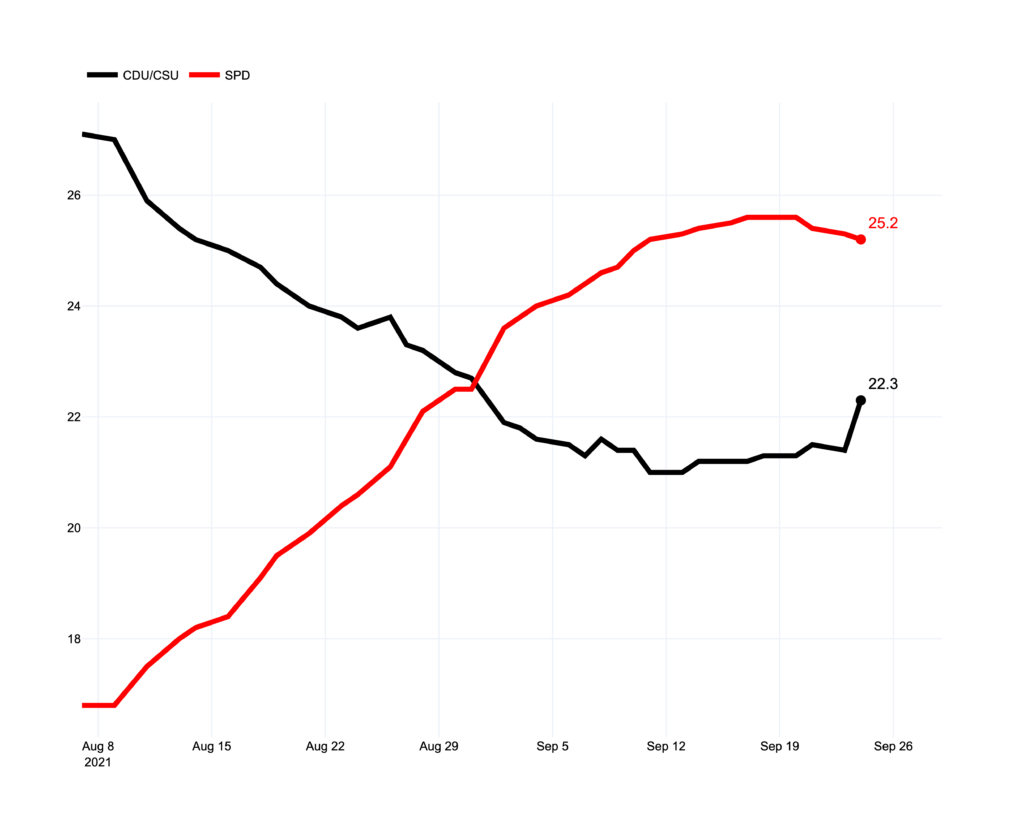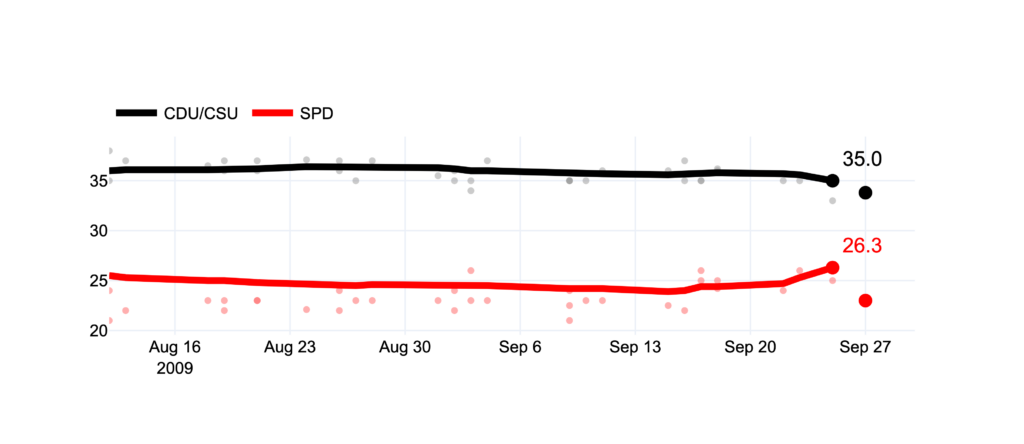I know this is not the most confident headline from a forecaster but I’m trying to be a bit more cautious than in 2021. I wrote some pretty bad takes in the last election cycle. I said for example that the SPD was doomed and the CDU/CSU was a strong favorite to win the election, neither of these came to pass. The funny thing is, I should’ve just listened to my model (which did pretty well) and never predicted anything that should’ve given me that much certainty in either outcome.
Having said that, I am going to do some educated speculation later in this post again because I can’t help myself.
But for now, let’s look at how the 2025 German federal election currently looks like according to the polls and my model (today on Dec 05 when this post goes live):

And once more in table form:
| Party | 2-week polling average | Vorcast model predictions |
| CDU/CSU | 32.3 | 31.6 |
| SPD | 15.5 | 16.9 |
| AFD | 18.2 | 15.8 |
| Die Grünen | 12.2 | 9.6 |
| FDP | 4.1 | 5.9 |
| BSW | 6.2 | 5.5 |
| Die Linke | 3.1 | 4.2 |
Based on these forecasts, I feel confident in making the following predictions about the electoral outcomes of the next election:
- A grand coalition between the CDU/CSU and SPD is the most likely outcome of this election and also more likely than the polls currently suggest (a combined 48% of the vote share could be enough because of the electoral math that transforms votes into seats in the Bundestag)
- The FDP will narrowly manage to stay in parliament
- The AFD will finish stronger than ever before (but not as strong as the polls currently suggest)
- The Greens will have a rough night and underperform their polls (which they tend to do)
There you have it, the main takeaways from this post. Feel free to bookmark this to make fun of me at the end of February when everything turned out differently. I stand by this take though.
So, that’s it, the election’s called?
If we were 10 or even 20 days away from the election, my answer would be: yup. But we’re not and I still owe you some educated speculation forecasting. I have to set the scene a little bit for that though, so let me take you back in time to the 2021 election.
The 2021 SPD surprise

To me, the biggest surprise of the 2021 election was the SPD’s late surge in the polling and the final election results. Little more than a month before the election date (September 26) the SPD started rising from 17% in my model all the way to 24.5% which was still below the final election result of 25.7%. This was unexpected for me personally but it was also the biggest miss of my model. Though my model was really prescient about most parties, especially Die Grünen and also the CDU/CSU, it underestimated the SPD throughout the election cycle.
My theory as to why that SPD surge occurred so late is that people didn’t really make up their mind until the election was in full swing. I used to think that all the election posters you see 4-6 weeks before an election (of course there are regulations about this kind of thing in Germany) were pointless. I figured people already knew who they were going to vote for. Well, it turns out that the posters being plastered all over our cities actually coincides neatly with the surge of the SPD in polls during the 2021 election.
Basically, people that aren’t political junkies and avid newspaper readers (so the majority of the population) started paying attention around that time and saw that the hapless Armin Laschet was not what they wanted in a chancellor and instead opted for Merkel-in-red, Olaf Scholz (at least that’s the way the SPD campaign presented him).
So the number one question on my mind is: will there be another 2021 shake-up in this election cycle?
I don’t think so. At least not as big. There are three main reasons for this in my mind:
- Politics have become more present in people’s lives
- There’s been a lot of high-profile elections this year and voting is on people’s mind
- Germans tend not to change their minds too much in the final 3 months of an election
Politics in Germany have become messier and louder
Regardless of where you stand politically, it’s hard not to have pity for the traffic light coalition. The coalition, named after the respective colors of the three parties involved, the SPD, Die Grünen and the FDP, started out on December 7th, 2021, with the clear mandate to move the country into a new direction. The government projected a dynamic and bold spirit. Then came the Ukraine war which deprived Germany of its main source of energy, cheap gas, sending energy prices sky high and reducing industrial margins and competitiveness. On top of that came high inflation across all Western countries, which further reduced the purchasing power of Germans. Add to that the decline of the car industry, both economically and emotionally the most important part of the German economy, and you have the perfect storm of economic and political headwinds. Not to mention Germany’s crumbling infrastructure and its massive investment backlog.
All of a sudden, all the innovative, new ideas the traffic light coalition wanted to push were perceived as costly and difficult to achieve. Despite its timid reputation, Germany also became the second largest supporter (behind the US) of Ukraine which also required vast amounts of money.
So even though both from an economic and a security standpoint, investment was sorely needed, the government was unable to do so because of the unusual and unique constitutional amendment, the “Schuldenbremse”. This constitutional amendment makes it illegal for the government to borrow little more than a tiny amount of money (limited to 0.35% of GDP). All of this resulted in governmental dysfunction. And so the slow, ugly divorce of the three party coalition began, eventually culminating in their breakup one day after the US presidential election on November 6th.
And ugly it was. The level of bickering, public in-fighting and open grievances from the political leaders of all three parties was not seen before in Germany and my theory is that that’s why the polls reflect a more informed electorate now. Basically, politics have become more news-worthy in this post-Merkel era and opinions have probably hardened already.
There are two more reasons though why I think more Germans have already made up their mind about this election.
Voters past and present
Here’s a hopeful thought: more people voted in 2024 than in any year before since humans existed on this planet. Elections in India, the US, the EU, the UK, on top of that three regional elections in Germany, have made this year a democratic bonanza. I’d be surprised if this didn’t have an effect on how much the general population is paying attention to politics.
Lastly, 2021 was a huge historical outlier. As a reference, below you here are my model’s predictions of the final 45 days of the last 5 elections (the final election result is the dot on the far right):





You can clearly see how much 2021 with the late 8% surge of the SPD was the exception.
So the race is over?
Not quite. The reasons outlined above lead me to believe there will be no 8-9% late surge of any party but I think there’s still some room for a smallish shake-up mainly in regards to the SPD (it’s time for my educated speculation).
The SPD is forecasted to finish roughly 2% above their long-term polling average right now according to my model. This means that the economic as well as other long-term factors would suggest that they are stronger than they currently appear (the fundamentals part of my model). Given the fact that the campaign hasn’t kicked into full gear yet, and that we saw a lot of movement in 2021 when that happened, I think it’s quite plausible that the SPD will gain around 2-3% percentage points.
Having said that, I think it’s highly unlikely that the SPD will get anywhere close to their 2021 election result, and they could very well stay below 20% which would be their worst result ever.
This matters. 2%, 3% or 4% doesn’t sound like a big number but it could decide whether a grand coalition between the CDU/CSU and the SPD is possible or not. If what I say will come to pass, Germany could relatively quickly form a new government. Though both parties would have you believe they offer fundamentally different visions, they share a lot of the same positions and if they manage their differences, they could settle quickly into a pragmatic mode to tackle the massive economic and security challenges the country faces. The SPD and CDU/CSU have done it many times before.
What happens if the SPD doesn’t improve on their current polling numbers and the CDU/CSU doesn’t rise in popularity (the latter of which seems unlikely looking at my model)? Complicated, messy and most of all lengthy coalition talks would be the result. The next unstable three party coalition between the CDU/CSU, SPD and either the Greens or the FDP would then probably form the next German government. And the next ugly divorce could follow soon thereafter, which Germany can ill afford at this critical time.